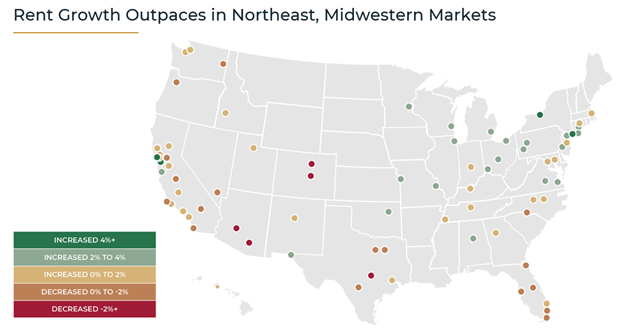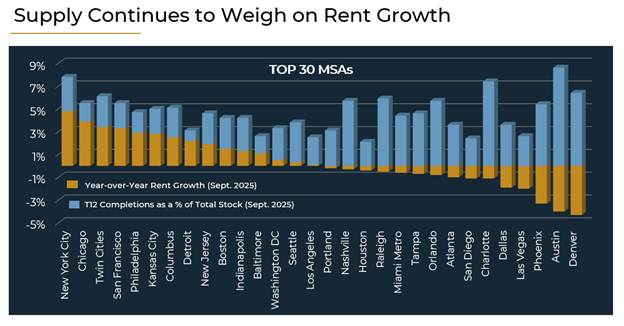The takeaway: Gateway markets are not just back — they are reasserting their position as the industry’s foundation. For investors seeking durable performance, the nation’s largest metros are demonstrating why they remain indispensable.
For much of the past decade, Sunbelt metros dominated the multifamily conversation, riding a wave of pro-business policy, population growth, and new development. But in 2025, the pendulum is swinging back toward Gateway markets. New York, San Francisco, and Chicago — long seen as bellwethers for institutional real estate, but underperformers in the current cycle — are outperforming the national average on both fundamentals and investment activity. Several forces are driving this resurgence.
First, the return-to-office trend has reignited demand for apartments near major employment centers. In New York, office foot traffic surpassed pre-pandemic levels the past summer (the first city to do so, followed closely by Miami)1. While office visits in San Francisco and Los Angeles still lag historical norms, office visits have increased roughly 20% and 10%, respectively, over the past year. As return-to-office mandates expand in cities that once embraced remote work, rent and occupancy levels are rising faster than the national average.

(Source: Yardi Matrix, September 2025.)
Second, elevated homeownership costs continue to keep many households in the rental market. With 30-year mortgage rates above 6% and single-family home prices up more than 20% since 2021, renting remains the more accessible option for a broad swath of residents. Gateway cities, already among the least affordable for homeownership, are seeing sustained demand for multifamily housing as would-be buyers postpone ownership.
Third, is that barriers to development in these markets are reinforcing their resilience. Even beyond entitlement and land constraints, the economics for new projects in Gateway markets have been difficult. Elevated construction costs and persistently higher interest rates have pushed pro formas out of reach for many developers, allowing demand to well outpace supply.

While the demand side of the equation is now pushing fundamentals — in Manhattan, for example, vacancy declined by 50 basis points over the past year while average rents surged by double digits — it will not magically create developable land. But it has seemed to get the attention of investors.
While the national 12-month rolling multifamily sales volume increased 24% in the first half of 2025 compared with the same period in 2024, it grew by more than 35% in both the Northeast and the West during the same period2. By contrast, the 12-month rolling sales volume grew by 8% in the Southeast region and declined by 7% in the Mid-Atlantic region during the same period, reflecting regional differences in operating conditions (and perhaps a wait-and-see approach to the DMV metro after a reduction in federal government jobs). By market, sales volume more than doubled in Seattle, and increased by nearly 50% in New York and 32% in the San Francisco Bay Area during this time, while transaction volume declined in Washington, D.C. and Greater Miami, and remained unchanged in Atlanta.
To be sure, national rent growth has slowed to just 0.2% year-over-year as new supply weighs on fundamentals. But many Gateway markets are bucking this trend, benefiting from durable demand and structural supply constraints. In a period of economic uncertainty, they are once again proving their role as stabilizers in the multifamily sector.
1. Placer.ai.
2. MSCI Real Capital Analytics.

